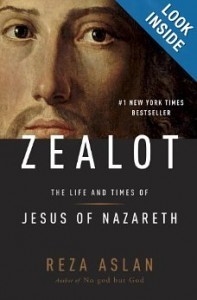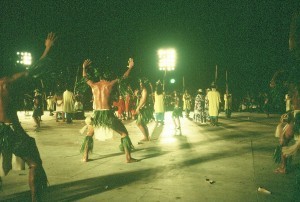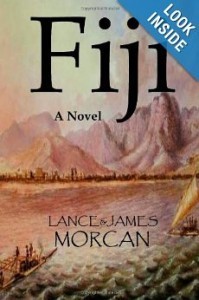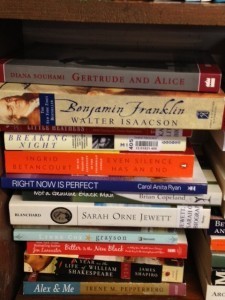Carol Anita Ryan's Blog, page 4
August 20, 2013
The Adult Version of a Favorite Fairy Tale
Zealot: The Life and Times of Jesus of Nazareth by Reza Aslan is a New York Times bestseller, and one hell of a book. For one thing it is well written, for another the author knows his stuff and he makes his case convincingly. Much has been said (primarily by the now infamous Fox News reporter) about the audacity of a non-Christian writing about Jesus. But when the author is as knowledgeable and objective as Aslan, the question should be: ‘Who could be better?’
If you are a Christian, this book should not be offensive as the author makes no effort to attack matters of faith. He rigorously explains the actual environment that Jesus lived and died in. Like many I was raised as a Christian and so thought I had a basic idea regarding Jesus’ life. This book is like reading the adult version of a favorite fairy tale. As an adult it is fascinating to learn more about what’s historically known about Jesus and his milieu. Equally interesting is discovering what is not factual or historically possible in New Testament accounts. Oddly, finding out that early Christians had conflicts about how the church should develop (should only Jews be accepted?), added to my sympathy for the Christian faith.
Reza Aslan was born in Teheran. His nominally Moslem family immigrated when he was seven to the U.S. He has multiple graduated degrees in just the subjects needed to write this excellent book. He lives in Hollywood, but that’s all he has in common with the Shahs of Sunset!
August 10, 2013
Is God on the Rocks too English?
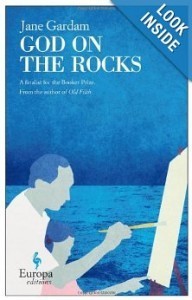
God on the Rocks
Can a book be too English? That was the question another reviewer had about Jane Gardam’s acclaimed 1978 novel, God on the Rocks. The question struck a respondent chord with me because although I have been transported by the later novels of Ms. Gardam, this one failed to move me.
Gardam’s skill and imagination are evident as are her quirky plot twists. For me, God on the Rocks is too English. What I mean is the characters lapse into local idioms frequently, and they stay in a claustrophobically small geographical space. Another problem for me was the characters. I’m just not interested in the experiences of an eight year old—even one as precocious and bright as Margaret—or the trials of her religious fundamentalist father.
Sometimes the quirky structure of the novel bothered me, as well. Dialog can be mysterious. At one point a character talks about someone using another character’s name. She’s confused, and it took me a while to figure that out. It’s like a mystery novel. You have to put together clues as to what’s happening and to whom.
Can a book be too English, or too northern Californian, or too mid-western? I think so. God on the Rocks explores a tiny universe with imagination, but for me it’s too tiny.
August 6, 2013
Eating your way through literature!
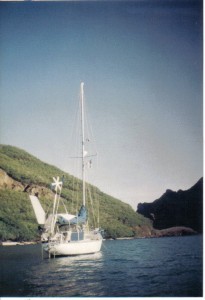
Velela in the Marquesas
Tasty Summer Reads Blog Hop
Posted on August 6 , 2013 by Carol@rightnowisperfect.com
Thank you, Kathleen Rollins, author of Misfits and Heroes and Past the Last Island, for inviting me to join this blog hop about fiction and food. My book, Right Now Is Perfect, is actually non-fiction, though.
While sailing across the South Pacific on a small sailboat, food soon became an obsession but our provisions were limited. Doing a lot with a few ingredients was the challenge—well one of them.
We (four of us on board) were limited in space and we had no refrigeration. We provisioned our boat in Mexico for the first and longest passage on earth. We were headed for the Marquesas in French Polynesia 2500 miles away—25 days at sea if we were lucky! Mainly we ate rice and beans cooked in a pressure cooker with part seawater part fresh water. The following recipe gives one permutation. Luckily readers can use fresh water and can add a variety of fresh condiments that –after the first week at sea–we sadly lacked.
Rice and beans makes for a cheap and healthy meal. All things considered, I’m glad we chose that combination as our staple.
Now, for the questions:
Do you snack as you write? No, I’m too easily distracted. An occasion cup of chai is all I allow myself.
Outline or seat of the pants? I have a detailed outline and every plot point has to refer back to the big picture. However, I have changed directions (and outline) while writing!
Do you stick to a recipe or wing it? I just learned something about myself. I start with good intentions of following directions, but then I wing it.
What’s next? My plan is to write a fiction set in Fiji.
How hot is it? Not at all explicit, but hopefully readers will appreciate implicit imagination.
Now, for the recipe:
Prepare pinto beans for cooking, or use canned beans. Prepare brown rice.
Sauté onions, garlic, ginger and cumin in cooking oil. Add fresh tomatoes cut in quarters (if available) or a ½ cup of tomato sauce.
When vegetables are cooked down add the beans. Simmer until flavors mingle and mixture becomes stew-like. Add vinegar (or lemon juice) and soy sauce to taste. Pour mixture over cooked brown rice. If available, sprinkle grated cheddar cheese and green onions on top.
Be sure to check out the other blogs in the hop!
Christy English Donna Russo Morin Nancy Goodman Lauren Gilbert Lucinda Brant Prue Batten Anna Belfrage Ginger Myrick Jo Ann Butler Kim Rendfeld Cora Lee Jessica Knauss Susan Spann
August 5, 2013
Day Lilies for lunch
![orange-daylily[1]](https://i.gr-assets.com/images/S/compressed.photo.goodreads.com/hostedimages/1381676870i/5178140.jpg) Today I’m happy to introduce a guest blog by Kathleen Rollins, author of two amazing books. She writing about ancient food!
Today I’m happy to introduce a guest blog by Kathleen Rollins, author of two amazing books. She writing about ancient food!
Tasty Summer Reads Blog Hop
Posted on August 1, 2013 by misfitsandheroes
Thank you, Jessica Knauss, for inviting me to join this blog hop about fiction and food. I’ve asked Carol Anita Ryan, author of Right Now Is Perfect, <rightnowisperfect.com> to join the hop too.
When I started writing a series of prehistoric adventure novels, I didn’t know I’d end up learning about many subjects, including wild foods. A local foraging guru showed me a fabulous world of wild edible and medicinal plants out there. I’ve found I love the adventure of finding, preparing, and eating wild foods.
We’re surprisingly ignorant about the plants that surround us, but ancient people knew all about the wild foods available each season; they had to. Elders warned young people not to eat the fruits or one plant, to peel those of another, to cook and mash another. Their accumulated knowledge allowed the tribe to survive.
This is the world I write about in Misfits and Heroes: West from Africa and Past the Last Island, the second book in the Misfits and Heroes series, both set 14,000 years ago. The first book follows a group of travelers from the coast of West Africa across the Atlantic. The second follows explorers island-hopping eastward across the South Pacific until they decide to pass the last island and head out into the open sea.
Now, for the questions:
Do you snack as you write? Sadly, yes. Sweet or salty? Both. The current vice is blue corn chips, but chocolate cookies are never very far away.
Outline or seat of the pants? Both. I have a general outline and section guidelines, but once I’m writing a scene, I tend to just go with it, or “pants it,” as one writer put it.
Do you stick to a recipe or wing it? I always begin thinking I’ll stick to the recipe then find I’m missing some ingredient but I have something sort of like it that might work if I just adjust those other ingredients, and so on. Sometimes it works out very nicely, but then I can’t remember exactly what I did to make it work. With wine, I find I have to take careful notes. Otherwise, I just repeat the same mistakes on the next batch.
What’s next? My WIP is the third book in the series, where both groups meet in what is now known as southern Mexico. Beyond that, a fourth is lurking in the wings.
How hot is it? Like Ginger Myrick, I tend to suggest sex rather than describe it. Some sections are romantic, but the book’s accent is on adventure rather than romance, though romance is certainly part of the adventure. I guess it’s a 3. Maybe. I’d love to hear from a reader on that score.
Now, for the recipes:
Wild foods can be very simple to prepare or incredibly complicated. I tend to go with the easy stuff. Here are two very easy possibilities:
Pick fresh dandelion flowers from an area you think is safe from chemicals and pets. Rinse off any visiting bugs, shake the flowers out and let them dry on a towel.
Heat oil in a heavy pan.
Mix up one cup of flour, one egg, and one cup of milk.
Swirl dandelion flowers in the batter and fry them until golden brown, then flip them over until the other side is brown. Then remove and set on paper towel. While they’re still hot, dust them with kosher salt. Enjoy! Even people who have never eaten wild foods will (probably) love them. They have a very mild flavor, not bitter like dandelion leaves, though they’re great too.
Daylily salad
When daylilies (aka ditch lilies) are in season, pick a couple of handfuls of buds and four open flowers from an area away from car exhaust and lawn chemicals. Remove the stamens and pistils from the flowers. Cut the stem ends off the buds rinse them off and let them dry. Include the buds with the tossed salad fixings you like best. The buds have a very mild flavor, a little like asparagus, and go with almost anything. Fill the cup of the flowers with herbed cheese and put them on top of the salad as an edible garnish. Their very mild flavor goes well with something stronger, like garlic or pungent herbs.
Then I hope you go crazy with more wild foods. So delicious – and free!
Be sure to check out the other blogs in the hop!
Christy English
Donna Russo Morin
Nancy Goodman
Lauren Gilbert
Lucinda Brant
Prue Batten
Anna Belfrage
Ginger Myrick
Jo Ann Butler
Kim Rendfeld
Cora Lee
Jessica Knauss
Susan Spann Richard Abbott Patricia Bracewell
August 3, 2013
Last Friends brings Old Filth trilogy to an end
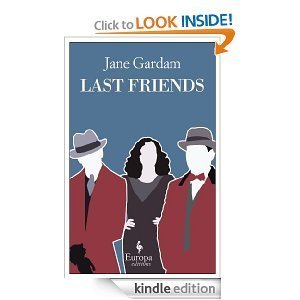
The End of a marvelous trilogy: Last Friends
Jane Gardam’s brilliant novel, Old Filth, left so many plot twists and engaging characters hanging that there simply had to be more. Fans were happy when The Man in the Wooden Hat appeared, filling in more about the characters. The latest and presumably last installment, Last Friends, completes the trilogy with all the main characters finally dead.
Gardam has fashioned an interesting cast and allowed them to wonder throughout the British Empire over most of the last century up to the present. Last Friends shows the characters from different viewpoints and also from various points in life. It’s a vantage point we seldom enjoy so fully in literature. Gardam ties things up so completely you wonder if the world can be so tiny. Throughout the story the same people re-appear in Wales, Hong Kong Cambridge.
To be honest I read Old Filth (Failed in London Tried Hong Kong) two years ago and some of the characters had receded from memory. While Gardam was so tightly wrapping up loose ends in Last Friends, I decided to re-read Old Filth, to refresh myself on who some of the characters were. It’s preferable to read the books in order and close together in time. I enjoyed the broad expanse of Old Filth’s universe even more the second time. These are fascinating characters! Gardam’s writing is deliciously good.
Old Filth is the masterpiece. The Man in the Wooden Hat, and Last Friends are well worth reading because of that.
July 19, 2013
Heiva: the pleasures of July in Tahiti
A sampler of French Polynesian dance
France celebrates Bastille Day on July 14, and around that time the Tour de France also takes place. But even in far off French Polynesia, there is a month long celebration in July. The traditional arts and pastimes are part of a major competition between all the far flung islands of French Polynesia. Heiva takes place during the month of July in Papeete, Tahiti. At night in a beautiful outdoor stadium, you can sit alongside the harbor and hear the best singers and musicians from all the various island groupings of French Polynesia. There will be astounding Tahitian dancing and colorful costumes. This inter-island competition provides bragging rights for the next year so the entrants are all serious and semi-professional. During the day around town there will be competition in the traditional games such as fruit carrying (who can carry a load the farthest), a javelin-like competition involving throwing spears at coconuts in trees, stone carrying (a game of strength), and perhaps the most serious competition in the islands: canoe racing.
Heiva has become an annual event that brings all parts of French Polynesia together in good-nature completion while encouraging and promoting Polynesian culture. It will provide you with heart stopping entertainment, too.
July 14, 2013
A well-told tale of an interesting life
It’s hard enough to make an engaging story of anyone’s life, but especially so of one’s mother. Judith March Davis has managed this super-human feat by writing an objective and absorbing book about her fascinating mother in the book Pagoda Dreamer.
Dore March, as she came to be known, was the daughter of Methodist Missionaries in China. She was raised in the early part of the 20th Century in China, in a special world of ex-pats. The book is based on an exceptional life-long correspondence carried out between Dore and one of her sisters. These two women came to live as young adults in the U. S. and due to war and revolution were never able to return to the China they’d grown up in. They confided much to each other that only they could share.
Dore was a gifted and interesting person who had too many tragedies in life. Learning about her reminds the reader how life has changed since the 1930s, particularly regarding health. Dore had tuberculosis which in those days was treated in incredibly painful, isolating ways. Despite TB and pneumonia she remained a life-long smoker (and apparently her Doctors were OK with that). She was also diabetic and yet was a heavy drinker. Medical knowledge has come a long way.
Despite one awful thing after another, Dore usually rose to the occasion by at least remaining calm.
Dore’s life could be the basis for a Masterpiece Theater series. Another book with more about early 20th Century ex-pats in China, is Pamela Master’s memoir, The Mushroom Years. It provides tantalizing details about growing up in China (then experiencing life in a Japanese prisoner of war camp).
July 7, 2013
Exotic Fiji–the backdrop to Fiji: A Novel
At the public market in Fiji the ‘heap’ is the unit of measure– as in ‘I’ll take a heap of cauliflowers’. At the handicraft market ‘brain pickers’ are offered to tourists. Contemporary Fijians may not be proud of their cannibal past but they are not ashamed of it, either. They laughingly sell reproductions of the cannibal eating implements to visiting tourists. It sets a tone.
Fiji: A Novel is an old fashioned romance novel set in the mid-1800s in Fiji. It was before European missionaries converted the islands to Christianity and dissuaded kidnapping, slavery, ritual murder, and cannibalism. It was also just before the British added Fiji as a colony.
The story takes place when the Europeans (missionaries, arms merchants, businessmen, and all sorts of miscreants) were encountering natives in Fiji. Spoiler alert: some very nasty things happen.
The co-authors, a father from New Zealand and his Australian son, have chosen three white people as the main characters—a missionary and his young and beautiful daughter from England on their way to convert Fijians—and a rough and tumble American musket seller. Around the missionary’s daughter and the bad-boy American arms seller there exists many good and a few very bad Fijian natives. This setting is intensely exotic and the co-authors deserve credit for bring this dramatic period of history to life. The story is exciting and many of the characters are memorable.
I found the Missionary’s daughter unlikely. She lusts after men like some 21 Century porn princess—not like a young daughter of a Methodist Pastor fresh from England. The male characters are more believable. So it’s an old fashioned romance novel with an oddly modern heroine, set in the tumult of 1840s Fiji. Perhaps perfect beach reading?
July 4, 2013
The Unexpected Life of Books

A friend spots my book in a Napa bookstore
Once we expressed our ‘likes’ by carrying around a copy of the book we were reading, for our entire world to see. Long before eBooks, the internet, or even Starbucks, I used to lug around (so I could read at any opportunity and honestly to impress) some book or another that communicated my interests at the time. Gravity’s Rainbow lasted for weeks due to its size and impressive value.
Today eBooks allow for more privacy in what we’re reading (Can that explain the popularity of 50 Shades?). It’s also harder or impossible to loan or give away a copy of an eBook you hope someone else will read.
Friends traveling in Napa Valley sent me the adjacent photos recently. They’d come across an interesting used bookstore (serving to provide funds for a nearby public library). They were surprised to find a copy of Right Now Is Perfect in the stacks. It was a pleasant reminder that physical books do live on in unexpected ways.
June 13, 2013
Enzo’s Best Book–Perfect Summer Reading
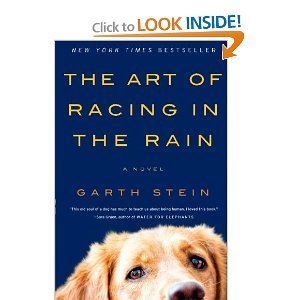 Every once in a while I come across (in this case belatedly, as the book was published in 2009) a novel that emotionally picks me up, turns me upside down, and shakes me until my pockets are empty. The early Greeks called this Catharsis—where one’s nervous system is reset by laughter, tears, and other harder to identify emotions.
Every once in a while I come across (in this case belatedly, as the book was published in 2009) a novel that emotionally picks me up, turns me upside down, and shakes me until my pockets are empty. The early Greeks called this Catharsis—where one’s nervous system is reset by laughter, tears, and other harder to identify emotions.
The Art of Racing in the Rain by Garth Stein tells a story through the eyes of a particularly wise dog. This device could have been gimmicky or too cute, but it isn’t. Dog lovers will connect with the book, but so will those unmoved by pets, because here the dog’s-eye view is insightful and perceptive. The story rewards the reader with tidbits about auto racing and life in Seattle, as well as with sage advice for living through adversity. All this is done in a fast-paced easy to read novel that is suitable for any age.

